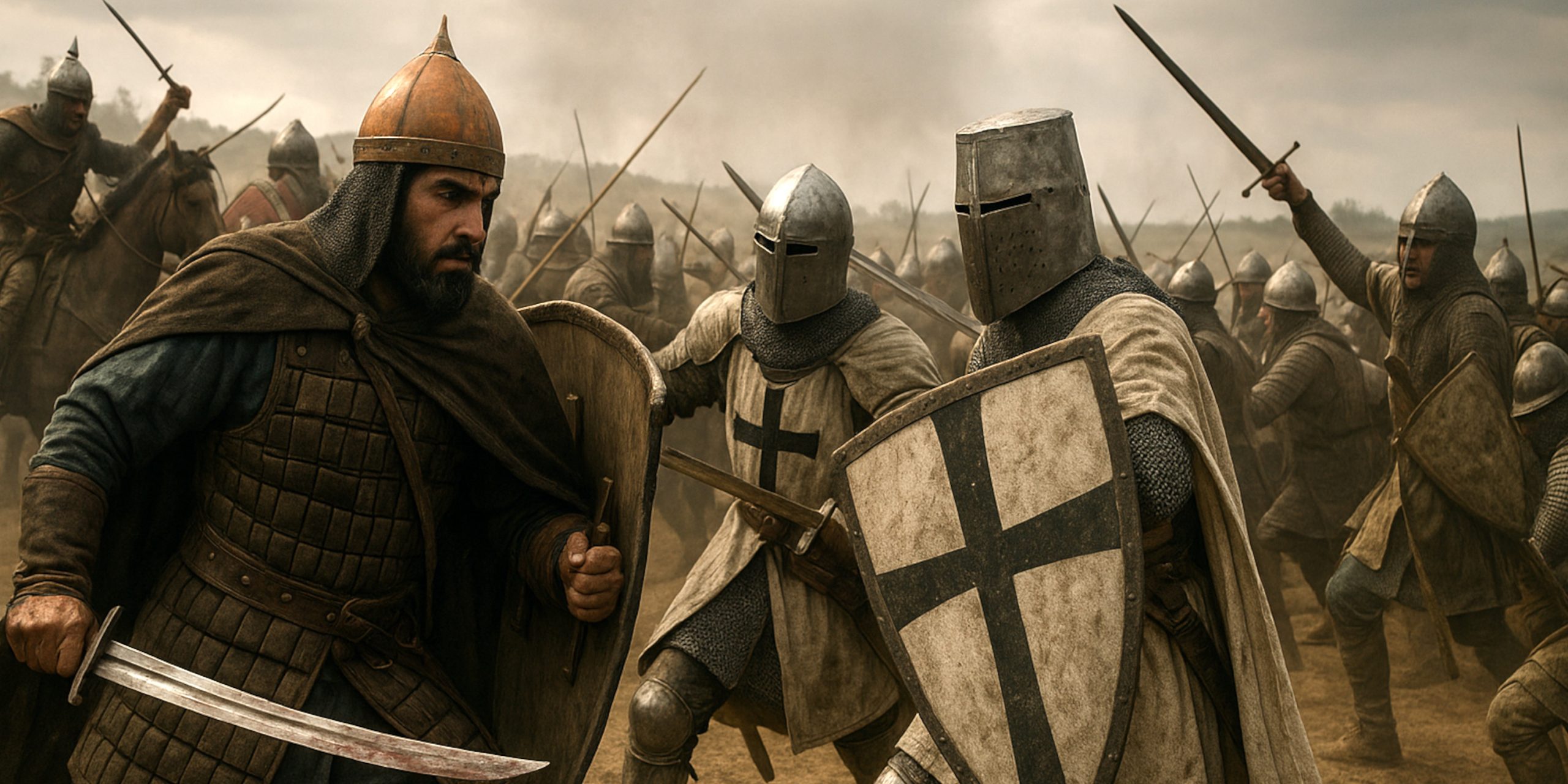
The Battle of Pelagonia was fought in 1259 in the plains of Macedonia, and it stands as one of those rare medieval encounters where cunning and politics outweighed brute military strength. The Empire of Nicaea, led by Michael VIII Palaiologos and his general John Palaiologos, defeated the combined forces of the Despotate of Epirus, the Principality of Achaea, and the Kingdom of Sicily. This victory cleared the way for the recapture of Constantinople in 1261 and the rebirth of the Byzantine Empire.
It was less a glorious clash of arms and more a tragicomedy of feudal egos and opportunism. The Epirotes bickered with their allies, the Latin knights grew suspicious, and Michael Palaiologos took full advantage, proving that diplomacy can sometimes swing a sword more effectively than steel.
Forces
| Side | Leader(s) | Estimated Strength | Composition |
|---|---|---|---|
| Empire of Nicaea | John Palaiologos (brother of Emperor Michael VIII) | 6,000–8,000 | Byzantine regulars, Cuman and Turkish horse archers, and local levies |
| Alliance of Epirus, Achaea, and Sicily | Michael II of Epirus, William II of Villehardouin, and Manfred of Sicily’s contingent | 10,000–12,000 | Epirote cavalry and infantry, Frankish knights, Italian mercenaries, and native levies |
The Nicaean forces were numerically inferior but vastly superior in cohesion. The allied army was a patchwork coalition, each faction suspicious of the others. As any historian of the Middle Ages will tell you, joint command was usually a recipe for disaster, and Pelagonia was no exception.
Leaders and Troop Composition
Nicaean Command:
- John Palaiologos: Skilled diplomat and commander who used feigned retreats and psychological manipulation.
- Alexios Strategopoulos: Later became famous for recapturing Constantinople in 1261.
- Cuman and Turkic mercenary leaders: Provided crucial light cavalry support, favouring mobility and deception.
Epirote and Latin Command:
- Michael II of Epirus: Ambitious but indecisive; left his Latin allies in a sulk before the fighting began.
- William II of Villehardouin (Prince of Achaea): The archetypal Frankish knight, brave but stubborn, heavily reliant on cavalry charges.
- Manfred of Sicily’s detachment: Italian mercenaries, well-equipped but unreliable.
Arms and Armour
| Faction | Armour | Primary Weapons | Secondary Weapons | Sword Types Commonly Used |
|---|---|---|---|---|
| Byzantine (Nicaean) | Lamellar cuirasses, scale armour, and mail; kite shields among cavalry | Composite bows, spears, and kontarion lances | Axes and short recurved bows | Paramerion (curved sabre-like sword) |
| Cuman and Turkic Horsemen | Light leather or lamellar armour | Composite bows, lassos, sabres | Daggers | Kilij or Shamshir-style sabres |
| Epirote and Latin Knights | Mail hauberks, surcoats, great helms, kite or heater shields | Long lances, maces | Crossbows (among support troops) | Arming swords and falchions |
| Sicilian Mercenaries | Mixed equipment, often Italian-style chainmail | Spears and longswords | Crossbows | Spada longa |
The contrast between the heavily armoured Latins and the agile Nicaean light cavalry defined the battle. The Latins expected a frontal clash; instead, they found themselves dancing in circles with mercenaries who refused to fight fair.
The Battle
The confrontation unfolded near Pelagonia in Macedonia. The Epirotes and their Latin allies had encamped separately, already mistrusting one another. Nicaean agents infiltrated both camps, spreading rumours that the Latins intended to betray the Epirotes. Soon, the alliance dissolved in a cloud of recriminations.
John Palaiologos then staged a series of mock skirmishes, feigned retreats, and ambushes. The Latin cavalry, eager for glory, charged headlong into open ground, only to find themselves surrounded and pelted with arrows. The Epirotes, seeing the collapse, fled rather than fight.
The result was catastrophic for the coalition. William II of Villehardouin was captured, while Michael II fled ignominiously to Epirus. The Nicaean victory was complete without needing a pitched, symmetrical battle. One could almost call it the medieval equivalent of winning by walkover.
Archaeology
Archaeological evidence from the Pelagonia region is scarce, as the precise battlefield remains debated among historians. Likely sites near Bitola (modern North Macedonia) have yielded:
- Fragments of mail and lamellar plates characteristic of Byzantine armour.
- Arrowheads typical of steppe archers.
- A Frankish spur and a broken sword hilt believed to be of Western European make.
No mass graves have been confirmed, suggesting that much of the fighting was disjointed and that the defeated army scattered rather than died in place.
Battle Timeline
| Year | Event |
|---|---|
| 1258 | Michael VIII Palaiologos consolidates power in Nicaea after the death of Theodore II Laskaris. |
| Early 1259 | Epirus, Achaea, and Sicily form an alliance against Nicaea, aiming to restore Latin control in Greece. |
| Mid-1259 | John Palaiologos advances into Macedonia; Epirote and Latin forces assemble near Pelagonia. |
| Late 1259 | Nicaean diplomacy fractures the coalition; skirmishes and feigned retreats ensue. |
| Battle of Pelagonia | Latin forces collapse after their cavalry is encircled; William II captured. |
| 1261 | Strategopoulos retakes Constantinople, restoring the Byzantine Empire under Michael VIII. |
Contemporary Quotes
- George Pachymeres, Byzantine historian, remarked:
“The Latins, proud of their iron, found themselves conquered by words and shadows.” - Nikephoros Gregoras, later chronicler, dryly observed:
“A battle was fought, yet scarcely a sword was crossed.”
Legacy
The victory at Pelagonia was decisive. It broke the Latin foothold in mainland Greece and neutralised Epirus as a rival to Nicaea. More importantly, it paved the road for the reconquest of Constantinople two years later, ending the Latin Empire that had lingered since the Fourth Crusade.
For the Byzantines, it proved that cunning and internal cohesion could still outmanoeuvre Western military might. For the Latins, it was an embarrassing reminder that not every problem could be solved by galloping in with a shiny helm.
In the annals of Byzantine history, Pelagonia was a triumph of intelligence over hubris, a rare day when the Byzantines didn’t just survive, they outplayed everyone else.
Watch the documentary:



